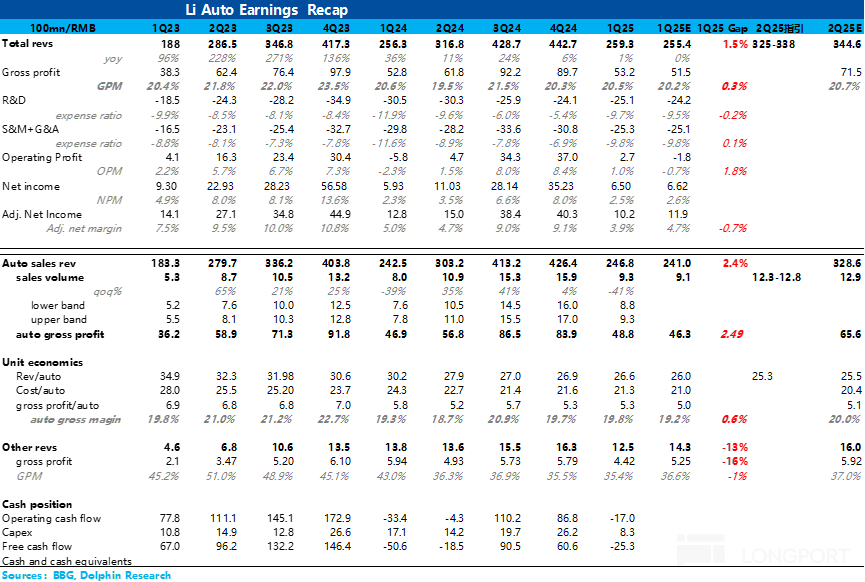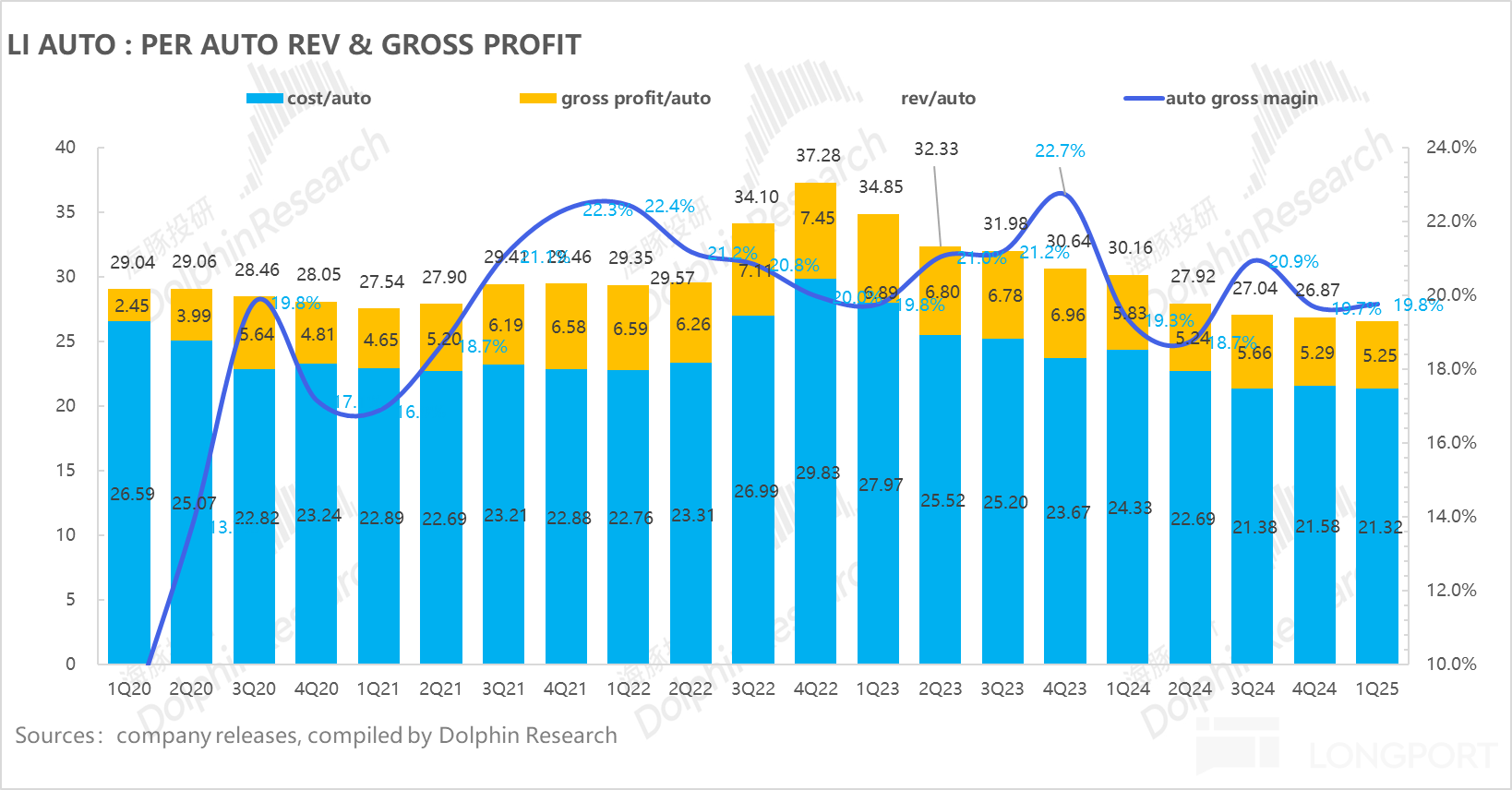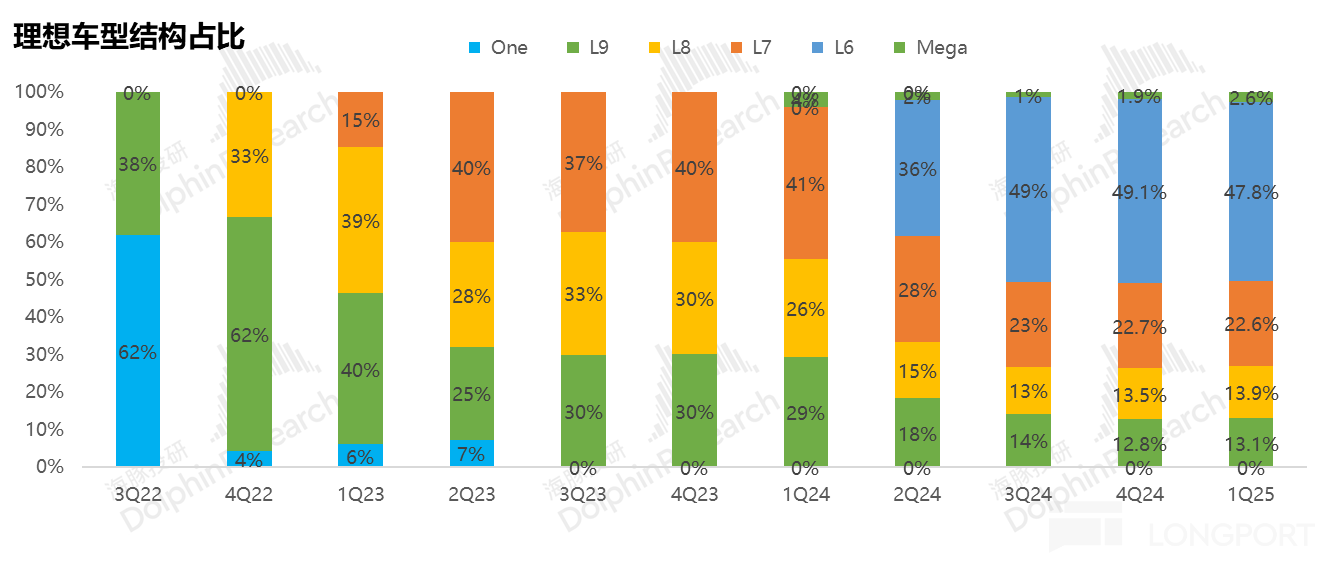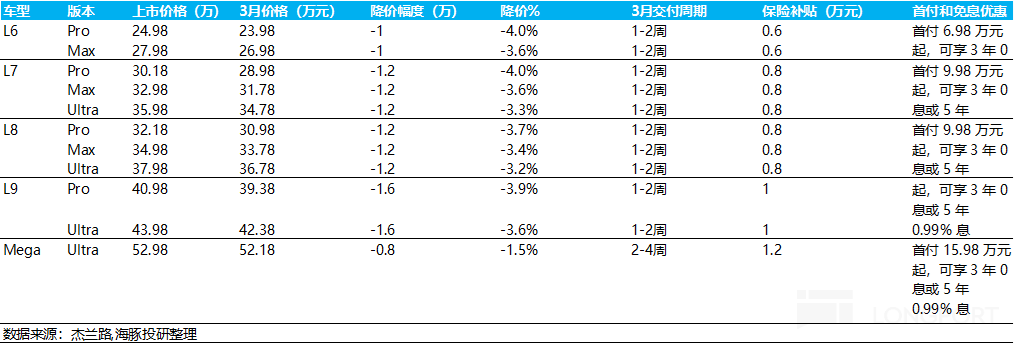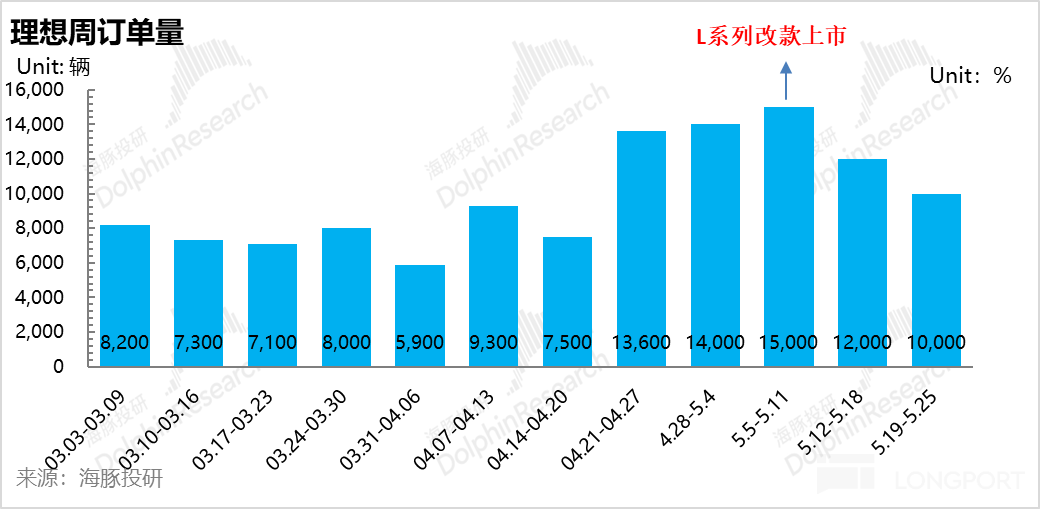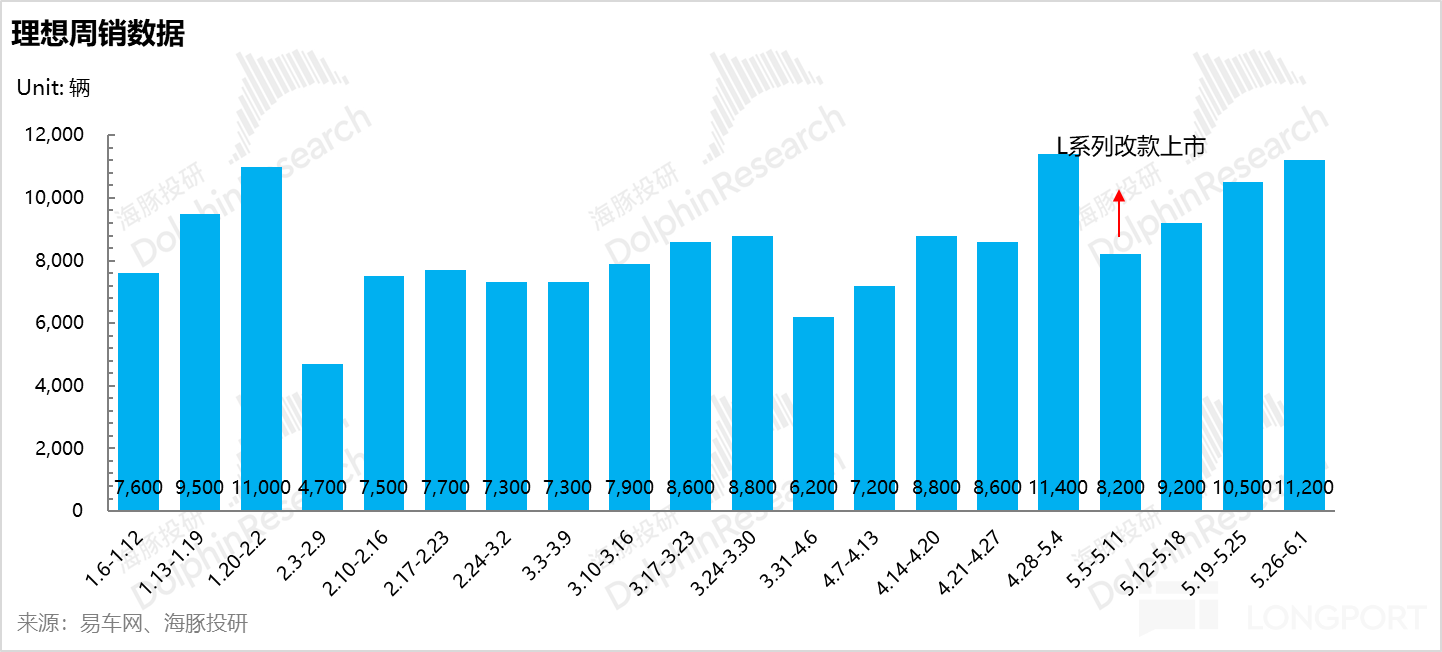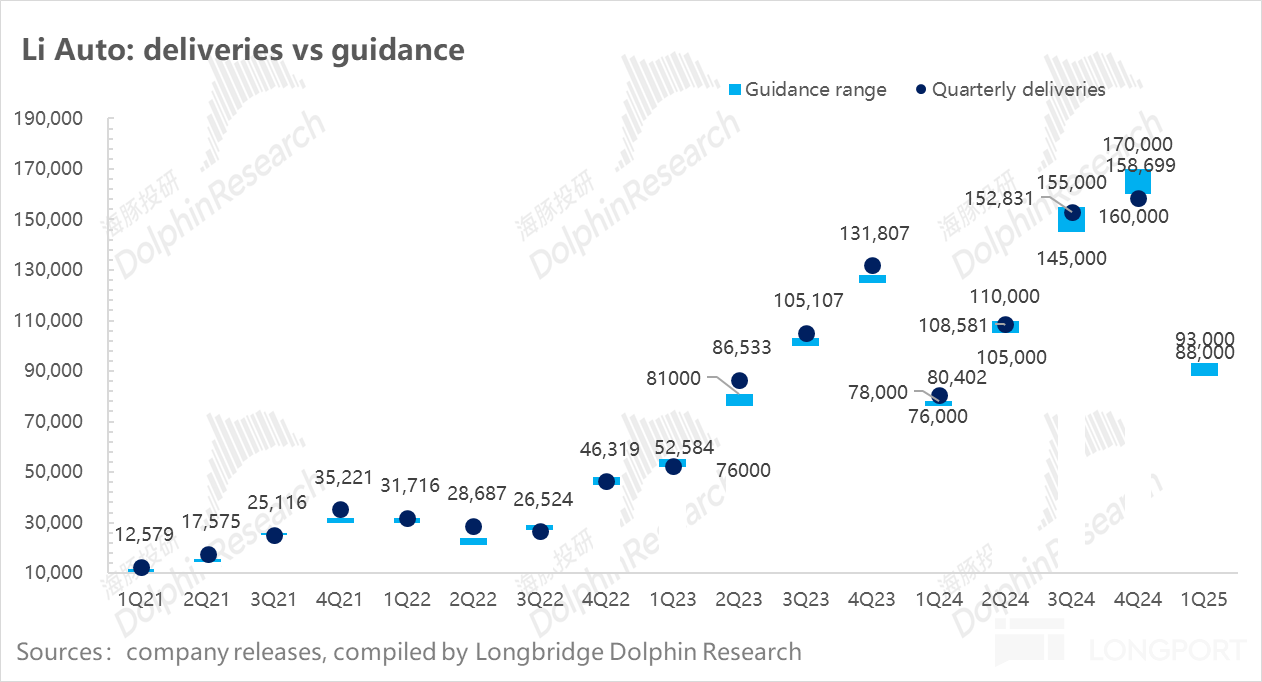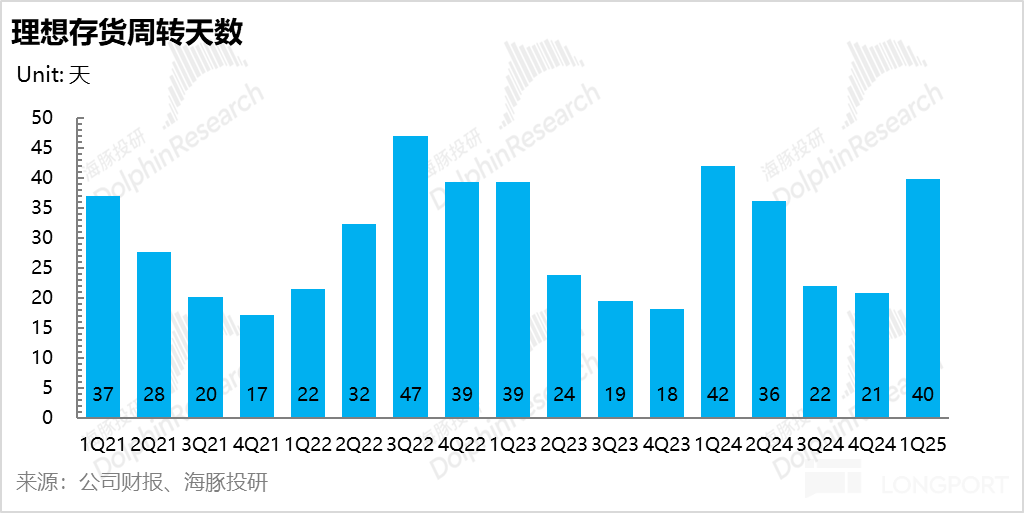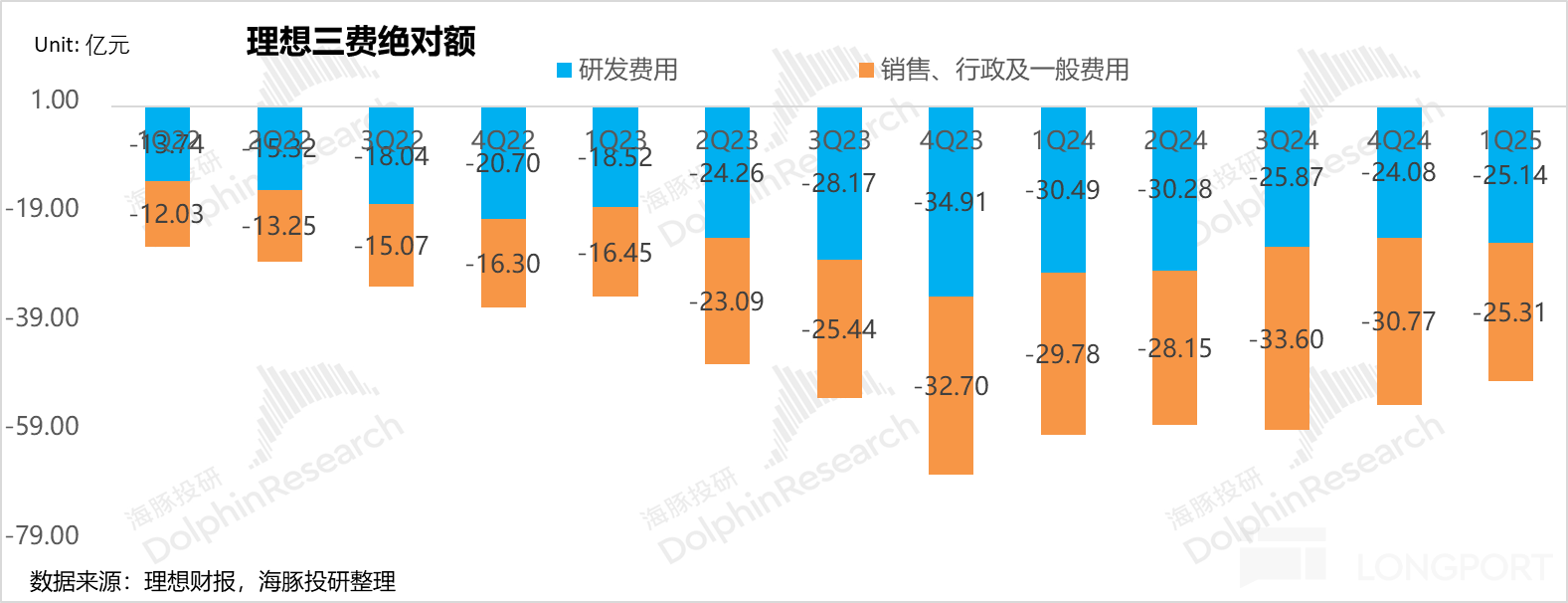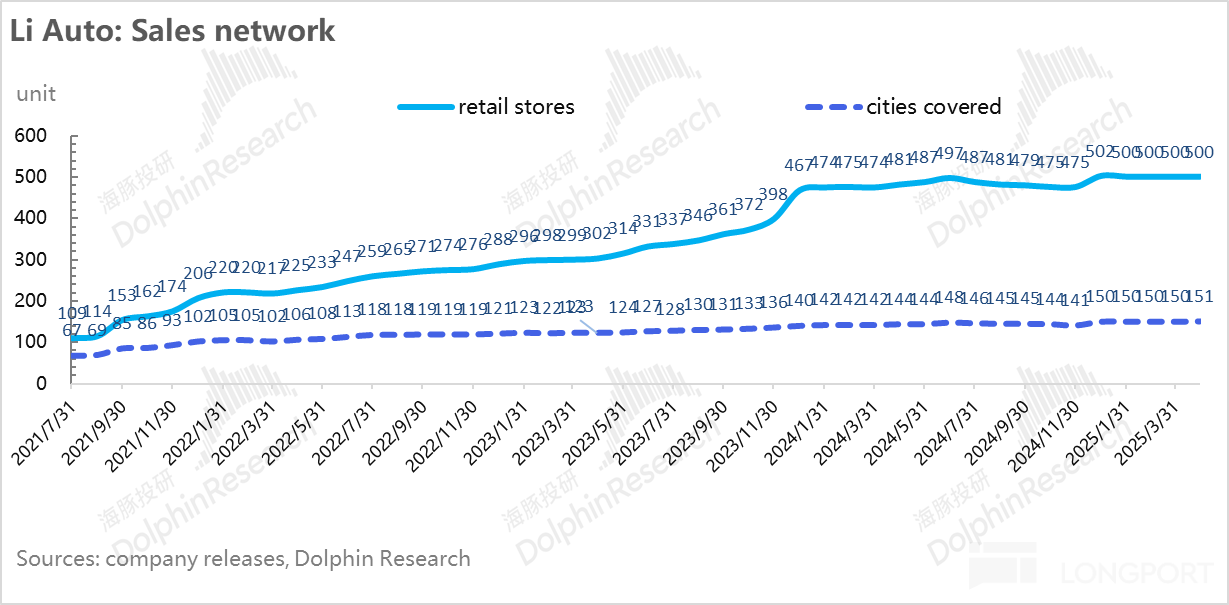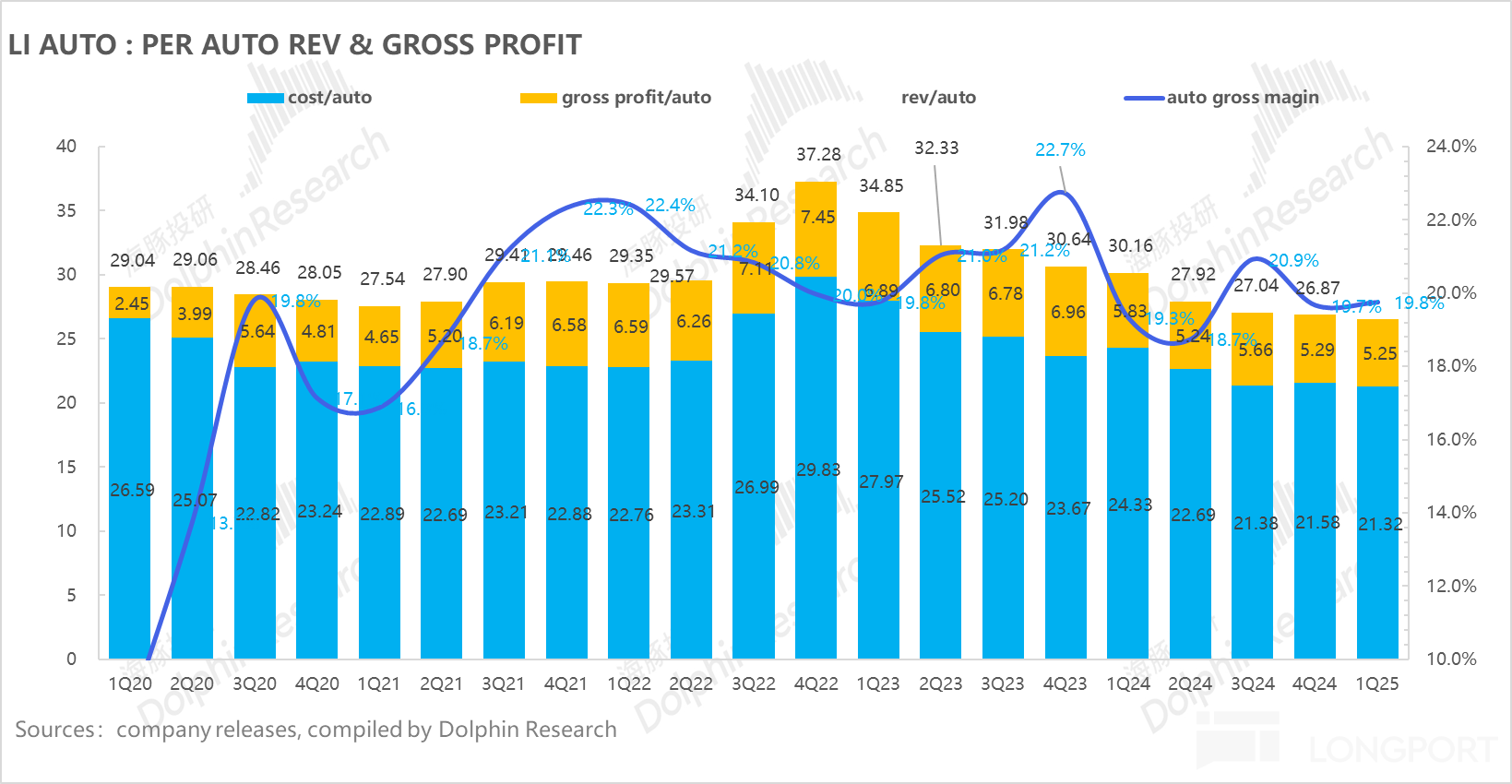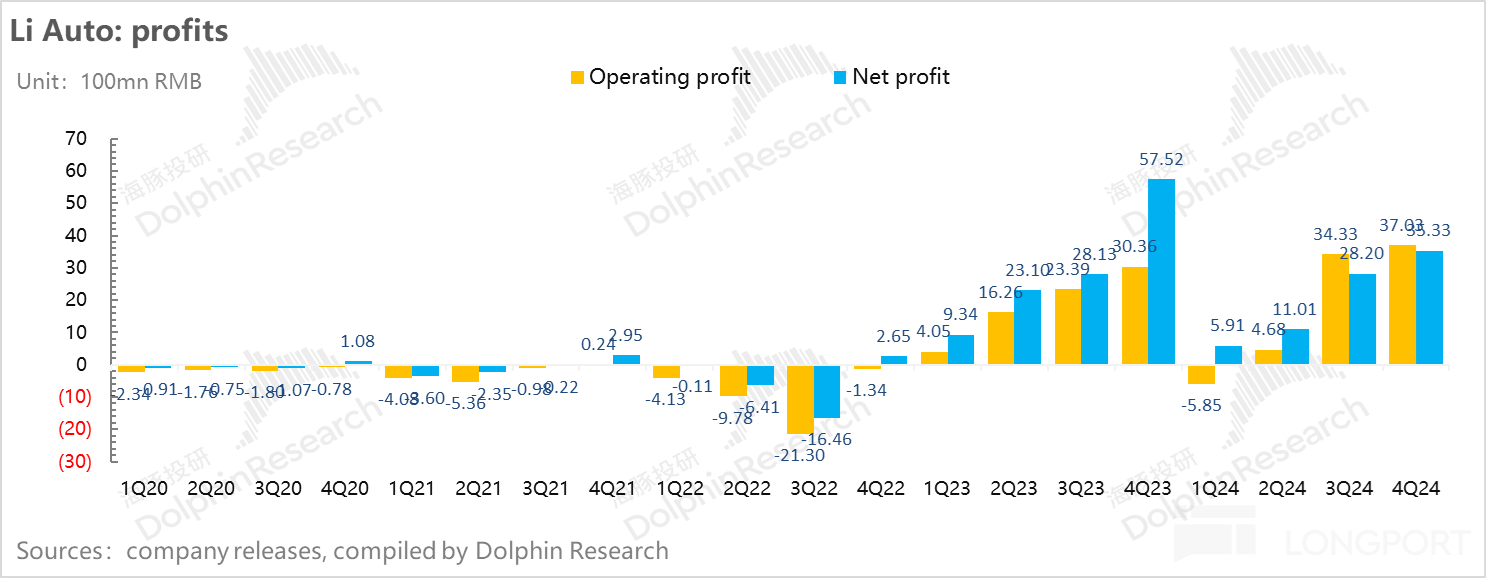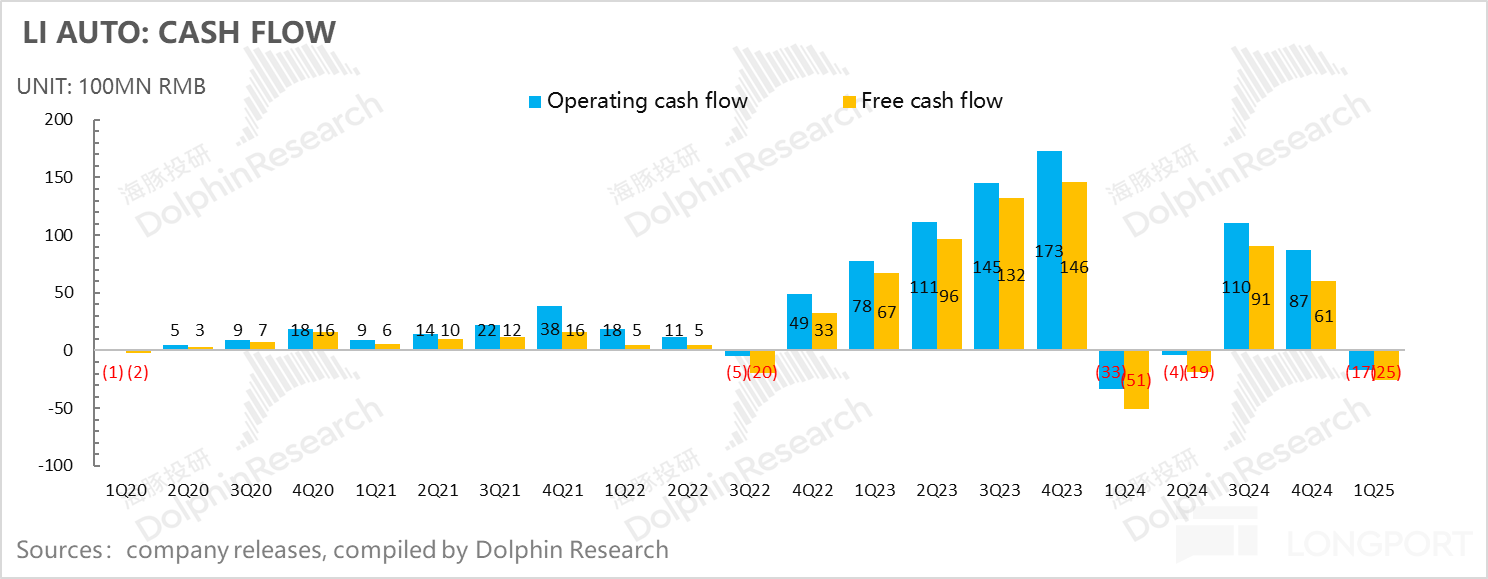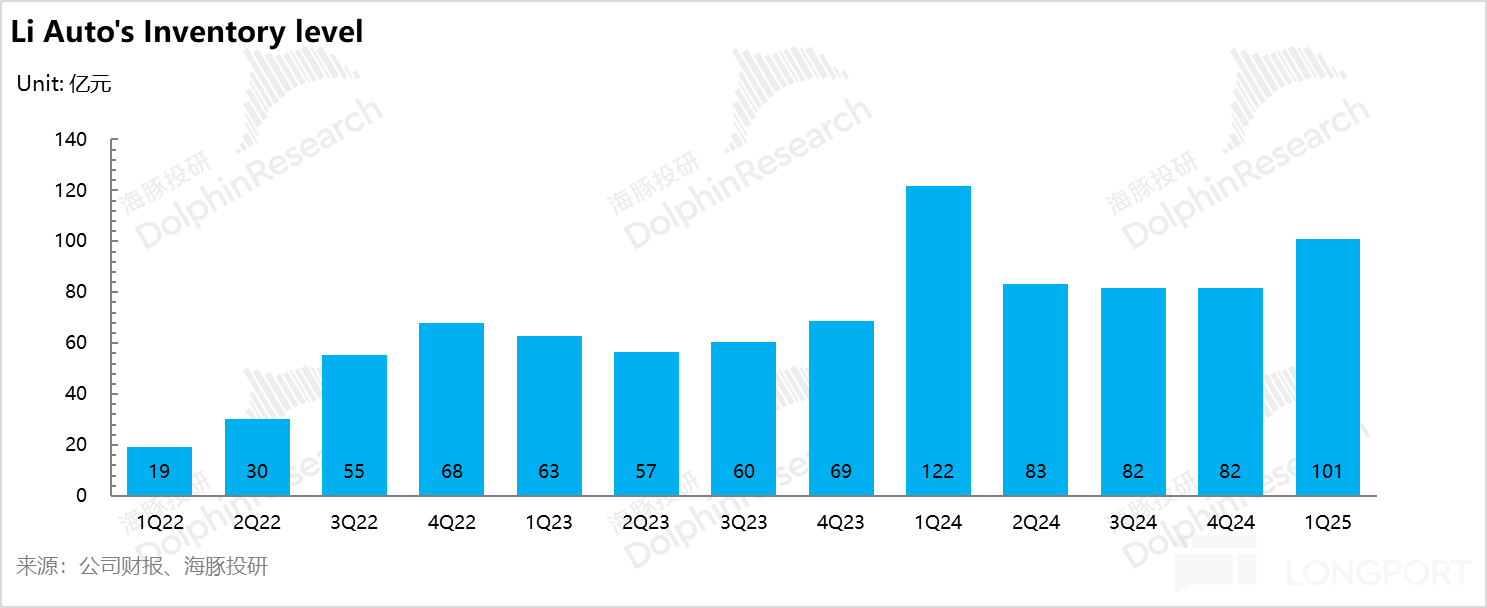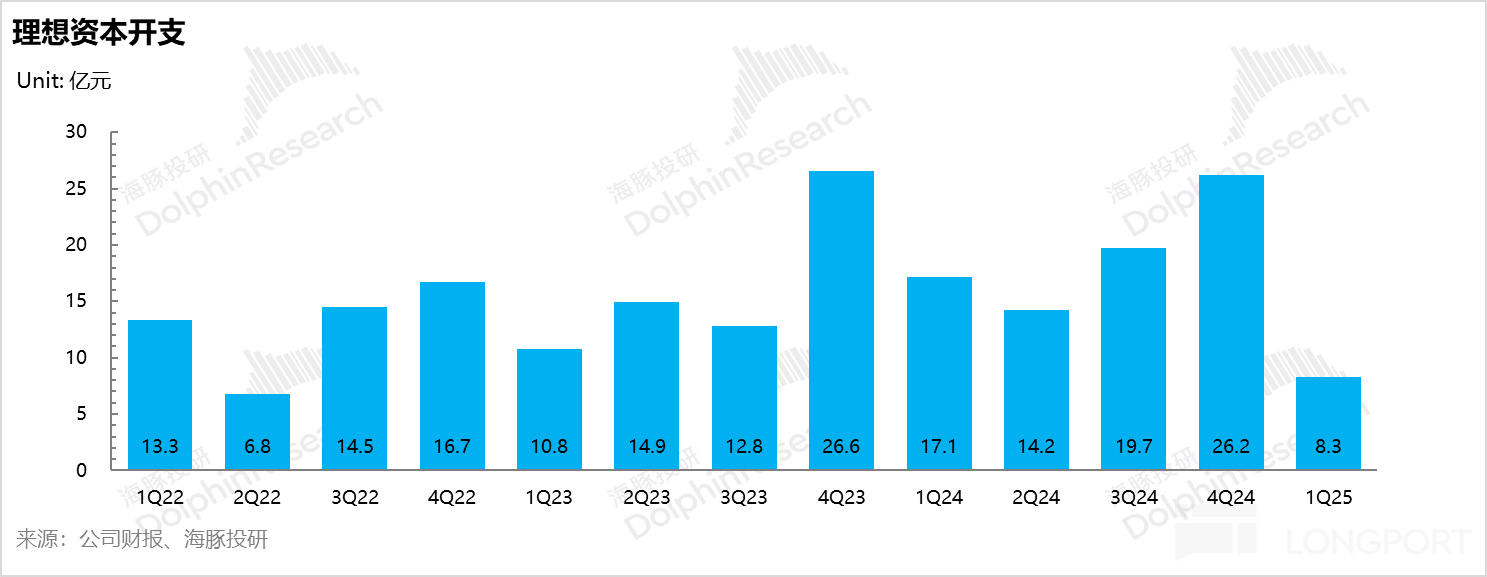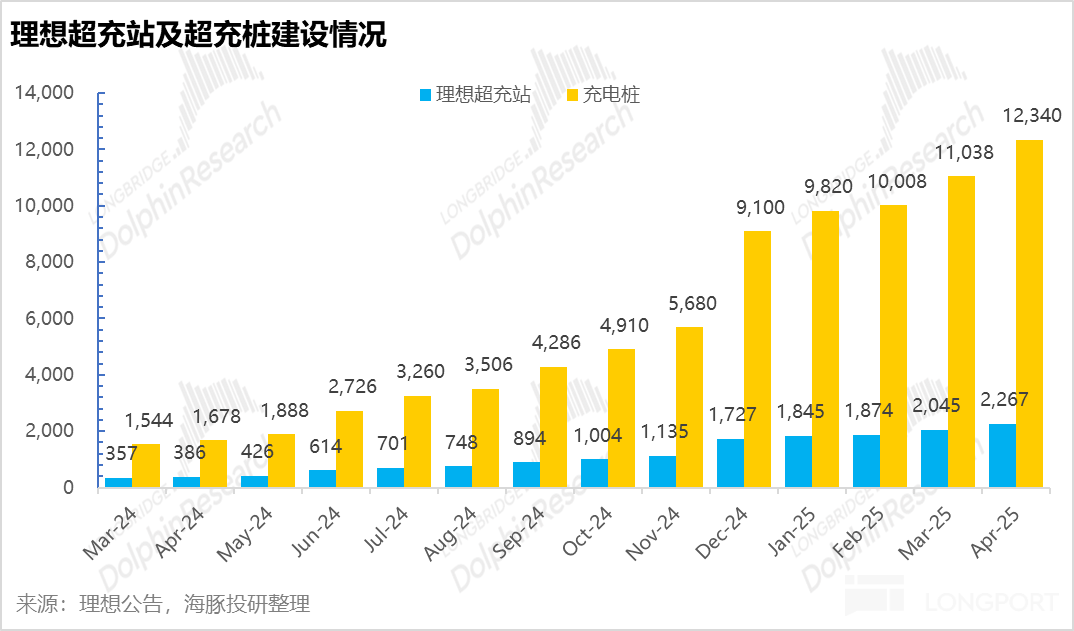
Li Auto: Range-extended bloodbath, AI inflection point not yet reached, can pure electric make a comeback?

Li Auto (LI.O) released its first-quarter 2024 earnings report after the Hong Kong market closed and before the U.S. market opened on May 29, Beijing time. The first-quarter performance was decent, but the guidance was not good, implying relatively weak order volume for the L series. Here are the details:
① Vehicle sales performance was acceptable, with revenue exceeding expectations by about 500 million yuan: Vehicle sales revenue in the first quarter was 24.7 billion yuan, surpassing market expectations of 24.1 billion yuan, mainly due to a smaller-than-expected decline in average selling price. This was partly because the vehicle mix improved this quarter (the share of lower-priced L6 models declined, while the share of higher-priced Mega/L9/L8 models rebounded), offsetting the negative impact of price cuts on older models.
② Vehicle gross margin performance was also acceptable but fell short of major bank expectations: The vehicle gross margin in the first quarter was 19.8%, seemingly flat compared to the previous quarter. However, the previous quarter included a contract loss provision for the Mega, so the actual vehicle gross margin was 20.7%. Thus, the actual vehicle gross margin this quarter declined by about 1 percentage point sequentially. Although it exceeded Li Auto's guidance of 19%, Dolphin Research noted that major banks had expected around 20%, suggesting cost reductions were relatively modest.
③ Overall first-quarter performance was acceptable and largely in line with expectations, but the issue lies in the second-quarter guidance: Both the sales and revenue guidance for Q2 missed market expectations, especially the sales guidance, which implies that L series orders were not only below market expectations but also below the company's original expectations. Additionally, inventory and inventory turnover days increased in Q1, suggesting that discounts on older models will likely intensify in Q2, further dragging down the average selling price.

Dolphin Research's overall view:
Overall, Li Auto's Q1 performance was acceptable and largely in line with expectations, but the Q2 guidance was disappointing. The implied average selling price is expected to decline by another 13,000 yuan sequentially, while the key sales guidance of only 123,000-128,000 units implies average monthly sales of 45,000-47,000 units in May/June, below market expectations of 129,000 units (market expected 34,000/45,000/50,000 units for April/May/June).
This suggests that the market expected sales to ramp up to 50,000 units in the first full delivery month after the launch of the refreshed L series on May 8, aligning with Li Auto's earlier target. However, the below-expectations guidance indicates that the refreshed models' order volume remains an issue (current weekly orders are around 10,000 units). As Dolphin Research mentioned last quarter, the refresh primarily focused on autonomous driving upgrades, with minimal improvements in battery capacity. Given that autonomous driving has yet to significantly influence purchasing decisions, this refresh can only be considered a "minor update."

Despite the weak Q2 sales guidance and current order volume, the market still expects 600,000 units in 2025, with existing models accounting for about 520,000 units (500,000 in 2024) and pure-electric models contributing around 80,000 units. This suggests the core sales base remains the extended-range models.
① Starting with extended-range models:
Dolphin Research believes Li Auto's extended-range models still face significant sales pressure, as the competitiveness of the L series is gradually being eroded by rivals. Many players are entering the extended-range market this year, with the following strategies:
a. Targeting the lower-tier market with family SUVs, but user overlap is limited, making the impact minimal (so-called "half-price Li Auto").
Examples include Leapmotor and Galaxy M9.
b. Offering larger space at lower prices:
Examples include Denza N9, Lynk & Co 900, and Deepal S09. These models have seen decent order volumes and could take share from Li Auto.
c. Addressing the second pain point of extended-range models with a "large battery + small fuel tank" approach:
XPeng will adopt this strategy in the second half of the year, followed by Xiaomi in 2026.
d. Directly competing with Aito by launching refreshed M series models to capture share.
This shows that Li Auto's success in the blue ocean market (extended-range family SUVs) was due to first-mover advantage, but without high barriers (autonomous driving is not yet a decisive factor), imitation is relatively easy. With many entrants this year, competition has intensified. Given the modest refresh of the L series, Dolphin Research remains concerned about Li Auto's extended-range sales base. If current order and weekly sales trends persist, maintaining an average steady monthly sales of 40,000 units for extended-range models may be difficult.
However, the current stock price of$LI AUTO-W(02015.HK) implies a 2025 P/E multiple of around 20-21x and a P/S multiple of 1.3x, based on expectations of 600,000 units. This valuation is not expensive if the 600,000-unit target is achieved. Despite the "siege" on the extended-range base, the market's optimism stems from expectations for Li Auto's pure-electric models (i8 launching in July and i6 in the second half).
However, the performance of pure-electric models remains unproven, so the current "low valuation" is reasonable given expected marginal improvements in Q2 (though still reliant on pure-electric expectations). Thus, shorting Li Auto at this stage is not advisable.
Dolphin Research believes investors should maintain a safety margin (short-term expectations of 550,000 units, 1.1x P/S, implying a stock price of HKD 76-84 or USD 19-22). With HKD 100 billion in cash and leading autonomous driving capabilities (though the industry inflection point has not yet arrived, hardware sales remain the focus this year), Li Auto has time to adjust its strategy even if the 2025 product cycle underperforms (especially for pure-electric models).
Detailed analysis:
With sales already announced, the key marginal information is: 1. Q1 gross margin; 2. Q2 2025 outlook.
1. Vehicle gross margin of 19.8% was relatively modest
Starting with the market's focus, vehicle gross margin was acceptable at 19.8%, exceeding Li Auto's Q1 guidance of 19%.
However, Dolphin Research noted that major banks had expected around 20%. While the 19.8% gross margin appears flat compared to Q4's 19.7%, Q4 included a procurement contract loss provision, so the actual vehicle gross margin was 20.7%. Thus, Q1's actual vehicle gross margin declined by about 1 percentage point sequentially.
Although Dolphin Research acknowledges that the lower-priced L6 negatively impacted the vehicle mix (reducing average selling price, though ASP still exceeded expectations), cost reductions were insufficient, especially given the intense competition requiring stricter cost control (Q1 vehicle costs were flat sequentially).

(Note: Q1 2022 vehicle gross margin excludes an RMB 800 million+ contract loss; Q1 2023 excludes an RMB 400 million warranty provision.)
Vehicle economics breakdown:
1. Average selling price declined by 3,000 yuan sequentially, less than expected
Given price cuts on older models, the market had low expectations for ASP, but Q1 ASP was RMB 266,000, above expectations of RMB 260,000.
① Vehicle mix improved sequentially, with Mega and higher-priced L8/L9 share rising slightly
The vehicle mix improved this quarter, with the share of L6 models declining by 1.3 percentage points to 47.8%, while the share of higher-priced Mega/L8/L9 models rose by 1.5 percentage points.

② But Q1 still involved clearing older models:
Li Auto continued to clear older models in Q1, with average price cuts of RMB 8,000-16,000 (3%-4%), the main driver of the sequential ASP decline.

2. Vehicle cost declined by 3,000 yuan sequentially, but cost reductions were insufficient
Q1 vehicle cost was RMB 213,000, flat with Q4 (excluding the Mega contract loss provision). This reflects weak scale effects due to a 41% sequential decline in sales and insufficient cost reductions amid intense competition.
3. Gross profit per vehicle was RMB 53,000, slightly above expectations of RMB 50,000
Gross profit per vehicle was RMB 53,000 in Q1, slightly above expectations of RMB 50,000, with a vehicle gross margin of 19.8% (above expectations of 19.2% but below major banks' 20% expectation due to insufficient cost reductions.
2. Q2 2025 sales and revenue guidance both missed expectations
a) Sales guidance: 123,000-128,000 units, below expectations of 129,000 units
Li Auto's Q2 sales guidance of 123,000-128,000 units missed the market's 129,000-unit expectation (market expected 34,000/45,000/50,000 units for April/May/June). The weak guidance suggests the refreshed L series' order volume is below expectations, implying average monthly sales of 45,000-47,000 units in May/June. This is slower than Li Auto's target of 50,000 units in the first full month post-refresh, making the 2025 target of 600,000 units challenging, especially given increased competition in the extended-range segment.
Weekly order and sales trends also suggest the refresh is underperforming, with weekly orders failing to sustain momentum. Current order volumes imply steady monthly sales of around 40,000 units, reflecting the modest refresh (primarily autonomous driving upgrades and minor battery improvements) and increased competition.



b) Guidance implies ASP will decline by another 13,000 yuan sequentially
Excluding other revenue of RMB 1.36 billion in Q2, the implied vehicle ASP is only RMB 253,000, down RMB 13,000 sequentially.
This decline is surprising given the refreshed L series launched on May 8 (with official prices unchanged, implying ASP increases of RMB 5,000/7,000/7,000/6,000 for L6/L7/L8/L9). The decline may reflect a higher share of lower-priced L6 models and additional discounts on older models (inventory turnover days rose to around 40 days in Q1).


4. Operating expenses were well controlled
1) R&D expenses: RMB 2.5 billion in Q1, slightly above expectations of RMB 2.4 billion
Q1 R&D expenses rose by RMB 100 million sequentially to RMB 2.5 billion. Given Li Auto's strategic focus on AI (using autonomous driving to build a moat, with 2025 R&D guidance of RMB 14 billion) and its leading position in autonomous driving, along with pure-electric launches in the second half (R&D expenses shifted to 1H24), this level of R&D spending is acceptable. However, further increases are likely in coming quarters.

2) SG&A expenses: RMB 2.5 billion in Q1, in line with expectations
Q1 SG&A expenses were RMB 55 million lower sequentially at RMB 2.5 billion, reflecting cost-cutting (lower employee compensation) and reduced marketing amid no new launches.
Li Auto did not expand its retail network in Q1 but plans to accelerate store openings (over 200 retail showrooms and 60 pop-up stores in shopping malls this year) to prepare for pure-electric model sales.


5. Revenue and gross margin slightly exceeded expectations
With sales already announced, Q1 revenue was RMB 25.9 billion, RMB 400 million above expectations, driven by higher-than-expected vehicle ASP. Other revenue was RMB 1.25 billion, down RMB 38 million sequentially and RMB 200 million below expectations, due to lower deliveries reducing ancillary sales.
Overall gross margin was 20.5%, slightly above expectations of 20.2%, driven by vehicle gross margin. Other business gross margin was 35.4%, down 1 percentage point sequentially, likely due to insurance discounts and increased accessory giveaways.

6. Adjusted operating profit and net profit were in line with expectations
Operating profit, a key metric, fell by RMB 3.43 billion sequentially to RMB 300 million in Q1, mainly due to a 41% sequential decline in sales. Adjusted net profit (excluding SBC) fell by RMB 3.6 billion sequentially to RMB 600 million, in line with expectations.
Net profit attributable to shareholders was RMB 650 million, in line with major banks' expectations of RMB 600 million.

7. Free cash flow turned negative again
Operating cash flow was -RMB 1.7 billion in Q1, turning negative again due to lower net profit and a RMB 2 billion increase in inventory to RMB 10 billion, suggesting further discounts on older models in Q2.


Capital expenditures fell by RMB 2 billion sequentially to RMB 800 million in Q1, as no new stores were opened and supercharger station construction slowed. As of April, Li Auto had built 2,267 supercharger stations and plans to add at least 300 more in Q2 (targeting 2,500 before the i8 launch).


<End>
For Dolphin Research's historical articles, see:
August 28, 2024 earnings review: Can Li Auto Still Thrive Under Huawei's Pressure?
August 29, 2024 earnings call summary: Q1 Vehicle Gross Margin Expected to Rebound Above 19%
May 20, 2024 earnings review: Li Auto: Profit Collapse! A Test of Faith
May 20, 2024 earnings call summary: Pure-Electric SUV Launch Delayed to First Half of Next Year (Li Auto Q1 2024 Call Summary)
March 4, 2024 product launch: Li Auto Launch: Minor Product Upgrades, No Price Cuts, Pure-Electric a Side Project
February 26, 2024 earnings review: Li Auto: Not a "Big Talker," Just a Hard Worker
February 27, 2024 earnings call summary: No Models Below RMB 200,000 in Next 5 Years
November 9, 2023 earnings review: Newcomer vs. Veteran: Can Li Auto Compete With Huawei?
November 9, 2023 earnings call summary: Autonomous Driving as Core Goal (Li Auto Q3 2023 Call Summary)
August 8, 2023 earnings review: Dissecting Li Auto: Is the "Explosive" Performance Really That "Ideal"?
August 8, 2023 earnings call summary: Li Auto Summary: Bottleneck in Parts Supply, Gross Margin Guidance Maintained at 20%+
May 10, 2023 earnings review: Li Auto: The Leading New Force, Living Up to Expectations
May 10, 2023 earnings call summary: Li Auto Summary: Market Share Leader, 20% Gross Margin Target Unchanged
February 27, 2023 earnings review: Li Auto: Strong Performance, But Competition Looms
February 27, 2023 earnings call summary: Li Auto: "Aiming for 20% Share in RMB 300,000-500,000 Luxury SUV Market in 2023"
December 9, 2022 earnings review: Li Auto's Profit Collapse? Not Fatal, But Awkward
December 9, 2022 earnings call summary: 2023: Li Auto's "RMB 100 Billion" Dream, One Pure-Electric Model
August 16, 2022 earnings review: Li Auto's Loud Thunder, L9 Can't Hold Up "Collapsing Ideals"
August 16, 2022 earnings call summary: Li ONE "Eaten" by L9, L8 to Launch Early (Call Summary)
June 22, 2022 product launch highlights: L9: Li Auto's New "Ideal"
May 10, 2022 call summary: Li Auto: Three New Models in 2023, a Big Product Cycle Year
May 10, 2022 earnings review: Li Auto's Hopes Pinned on Second Half?
February 26, 2022 call summary: Completing the 0-1 Validation Phase, How Li Auto Will Achieve 1-10 Growth (Call Summary)
February 25, 2022 earnings call live: Li Auto (LI.US) Q1 2021 Earnings Call
February 25, 2022 earnings review: Full "Cash" Power, Li Auto's Dream Becoming Reality
November 30, 2021 call summary: Launching Pure-Electric Models Alongside Xiaomi, How Will Li Auto Compete? (Call Summary)
November 29, 2021 earnings call live: Li Auto (LI.US) Q1 2021 Earnings Call
November 29, 2021 earnings review: Li Auto Outearns Nio and XPeng, But Is It Opportunistic or Long-Term?
August 31, 2021 call summary: Li Auto: Q1 Surpasses Nio and XPeng, Targets 150,000 Units in 2022 (Call Summary)
August 30, 2021 earnings call live: Li Auto (LI.US) Q1 2021 Earnings Call
August 30, 2021 earnings review: Li Auto: Steady Performance, Strong Momentum?
June 30, 2021 comparative research (Part 2): New Auto Makers (Part 2): Doubling in 50 Days, Can the Three Keep Running?
June 23, 2021 comparative research (Part 1): New Auto Makers (Part 1): Market Enthusiasm Fades, How Will the Three Cement Their Position?
June 9, 2021 comparative research (Part 1): New Auto Makers (Part 1): Betting on the Right People and Things, a Look at the New Forces
Risk disclosures and disclaimers: Dolphin Research Disclaimer and General Disclosures
The copyright of this article belongs to the original author/organization.
The views expressed herein are solely those of the author and do not reflect the stance of the platform. The content is intended for investment reference purposes only and shall not be considered as investment advice. Please contact us if you have any questions or suggestions regarding the content services provided by the platform.

